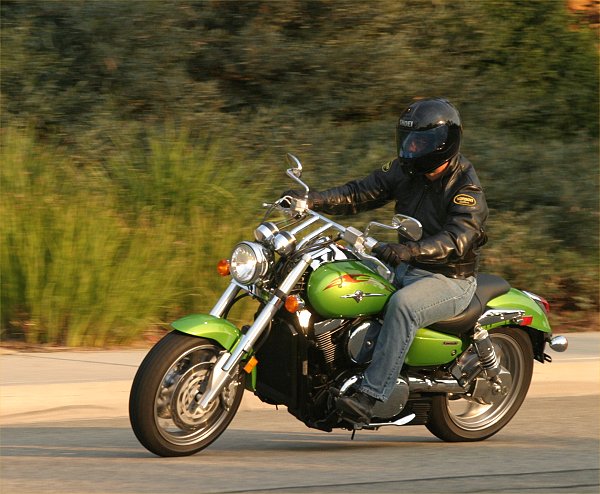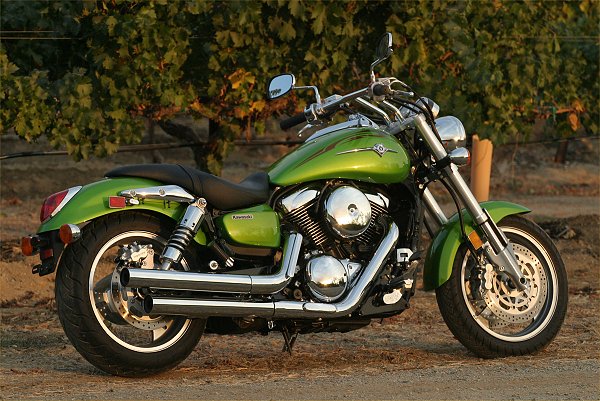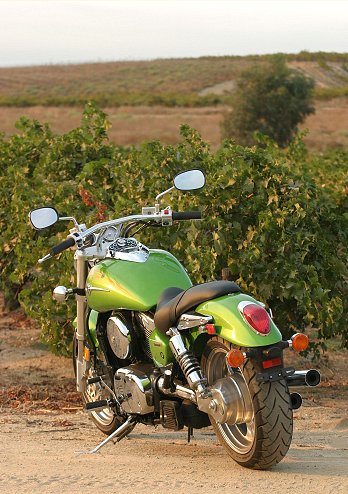
A couple of years ago, Kawasaki was one of the first Japanese manufacturers to bring to market a “power cruiser”. At the time, before evaluating some of the competition (such as the Yamaha Road Star Warrior and the Honda VTX 1800), we tested the new Mean Streak and were quite impressed. We liked the looks, the features and the performance, with very few reservations . . . particularly at Kawasaki’s price point. Take a look at our review of the 2002 Mean Streak here. Our 2002 review discusses some of the details unchanged for 2004.
For the 2004 model year, Kawasaki makes the first significant changes to the Mean Streak. First and foremost, is an engine displacement increase from 1470cc to 1552cc. This comes courtesy of a 5mm increase in piston stroke. Cam duration, lift and valve timing are also changed to improve low-end and mid-range performance.
Otherwise, the engine remains a fuel injected, liquid cooled, four-valve per cylinder design, with hydraulic valve lash adjusters and a gear-driven counter balancer.
Other changes to the 2004 Mean Streak are less significant, and include new valve covers and polished and reshaped cooling fins, as well as new brake master cylinder and clutch cylinder housing.

The suspension and handling remind us immediately of the 2002 model (as they should). Firmly sprung for a cruiser, the Mean Streak displays relatively precise and fluid handling for the cruiser category.
The real difference this year is the engine. The added displacement, and other engine changes, are immediately apparent when riding the Mean Streak. Significantly greater thrust down low, and a meatier mid-range, make the Mean Streak feel quite a bit more potent.
Kawasaki claims peak horsepower is unchanged, although horsepower “under the curve” is clearly increased, and broadened. It is the torque curve that Kawasaki is bragging about for 2004, and rightfully so. The bigger engine gives the Mean Streak the roll-on power that a “power cruiser” deserves.

The Mean Streak still won’t post the dyno numbers of the Yamaha Road Star Warrior or the Honda VTX 1800, but, as a package, the Mean Streak is very attractive. The handling of the Mean Streak surpasses that of the big VTX by some margin, and approaches that of the aluminum-framed Road Star Warrior.
We did notice some drive line lash when we first started riding the Mean Streak. It wasn’t long until we adjusted our throttle and clutch work to smooth out the acceleration and deceleration of the big bike. Jumping on a bike with a drive shaft always requires a bit of adjustment time.
The five-speed transmission shifts very well for a large displacement v-twin cruiser, and there is always plenty of torque on demand. It is hard to select the wrong gear on this bike.
The brakes we raved about on the 2002 model are still there, and are still making us smile. If you are a cruiser rider, the front binders will shock you with their power and feedback (unless your current ride is one of the other power cruisers). They are that good.
If there is a fly in the ointment, it is the inevitable comparison of the Mean Streak engine performance with the even larger-engined competition, including Kawasaki’s own Vulcan 2000 (which we are riding over the next few days).
If you are not dead set on buying the cruiser with the quickest quarter mile time, however, you deserve a close look at the Mean Streak. With more engine than most of us need, anyway, you might consider it a bargain at the U.S. MSRP of $10,999. Take a look at Kawasaki’s web site for additional details and specifications.
| Yamaha Photo of the Day |





